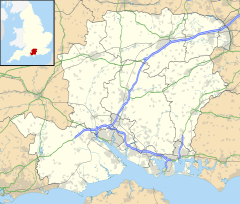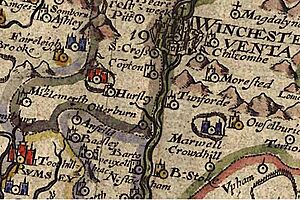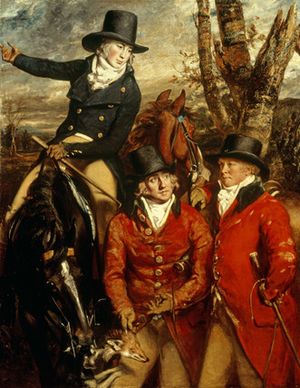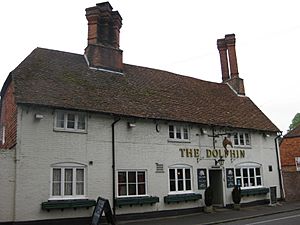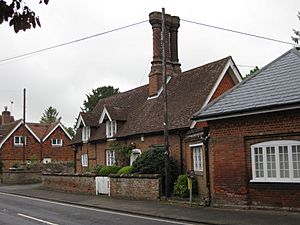Hursley facts for kids
Quick facts for kids Hursley |
|
|---|---|
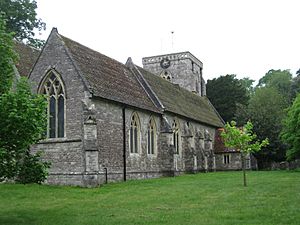 |
|
| Population | 889 (2011 Census) |
| OS grid reference | SU428250 |
| Civil parish |
|
| District | |
| Shire county | |
| Region | |
| Country | England |
| Sovereign state | United Kingdom |
| Post town | Winchester |
| Postcode district | SO21,SO22 |
| Dialling code | 01962 |
| Police | Hampshire |
| Fire | Hampshire |
| Ambulance | South Central |
| EU Parliament | South East England |
| UK Parliament |
|
Hursley is a village and civil parish in Hampshire, England. About 900 people lived here in 2011. It is located between the towns of Romsey and Winchester on the A3090 road. The parish also includes smaller areas called Standon, Pitt, and Farley Chamberlayne.
Contents
Hursley's Long History
Early Times
There are old earthworks at Merdon Castle. These were built a very long time ago, either in the late Bronze Age or early Iron Age.
From the 1100s to the 1600s
The first mentions of Hursley are from the late 1100s. A Bishop of Winchester named Henry de Blois built a large house called Merdon Castle here in 1138. For many years, Hursley belonged to the Bishop of Winchester.
In 1552, the land was given to King Edward VI. By the 1500s, the buildings at Merdon Castle were falling apart. King Edward VI then gave the land to Sir Philip Hoby.
Some parts of the old castle, like a gatehouse, can still be seen today. They were once listed as a "building at risk" because they needed repairs. In 2023, work was done to fix the stonework and protect the walls. A deep well was also made safe. These repairs cost a lot of money, helped by a grant from Historic England.
Later, under Queen Mary, the land briefly went back to the church. But Queen Elizabeth I soon returned it to the Hoby family.
The Hoby family sold the land to Thomas Clerke in 1600. In 1639, it was sold again to Richard Major. He was a very important person in Hampshire at the time.
The Cromwell Family (1643-1718)
The Hursley estate became part of the Cromwell family in 1643. This happened when Oliver Cromwell's son, Richard, married Dorothy Major. Dorothy was the daughter of the owner, Richard Major.
Richard Cromwell lived in Hursley with his wife from 1649. In 1658, after his father died, Richard became the Lord Protector of England. This meant Hursley briefly became the country home of England's ruler!
However, Richard's time in power was short. He was forced to leave office within months. By 1660, he had to leave the country for his safety. He traveled to France and other parts of Europe, using a different name.
Richard's son, Oliver Cromwell II, took over the Hursley estate. After Oliver died in 1705, Richard returned to Hursley. He lived there until he died in 1712 and was buried in the local church. Richard's daughters sold the Hursley estate to Sir William Heathcote in 1718.
The Heathcote Family (1718-1888)
Sir William Heathcote was a successful merchant. He moved to Hursley to live as a country gentleman. Between 1721 and 1724, he built a large red brick house. This house, now called Hursley House, was built in the Queen Anne style.
When William died in 1751, his son, Sir Thomas Heathcote, took over the estate. Around this time, Hursley's old medieval church was rebuilt in a Georgian style.
Later, another William Heathcote became the fifth baronet in 1825. He made Hursley House bigger. He also created Home Farm on the site of the old Merdon Castle.
In 1888, the Heathcote family sold the estate for a large sum of money. It was bought by Joseph William Baxendale, whose family owned the Pickfords company. He then sold it in 1902 to George Cooper. His wife, Mary, was a very rich American whose family owned railways. She did a lot of work to change and decorate the house into what it looks like today.
In 1940, after Sir George died, the house was taken over by the government during World War II.
Today, IBM uses Hursley House as part of its IBM Hursley Laboratories. It is a special building known as a Grade Two* Listed Building.
Cranbury Park, another important building in Hursley, was once home to the famous scientist Sir Isaac Newton in his later years.
Other Famous People from Hursley
The Church of England writer and poet John Keble became the Vicar (a type of priest) of Hursley in 1835. He rebuilt the church in 1848 and stayed there until he died in 1866. Keble was a professor at Oxford University and a leader of an important religious movement. Keble College, Oxford was named after him. He is buried at All Saints' Church in Hursley.
There is also a memorial in the church for Dennis George Wyldbore Hewitt VC. He received the Victoria Cross, a very brave award, during World War I.
Hursley Today
IBM has a big office and research center in Hursley, located around Hursley House. Over 1500 people work there. It is mainly a place where they create computer software. They work on things like how computers handle transactions and messages. They also develop storage products and Java software. IBM's Blockchain program is also based here.
In the past, this site helped develop early IBM computers and the first digital color display.
The Monarch's Way, a long walking path, goes through Hursley. The Hursley Park Cricket Club plays at The Quarters.
Special Buildings and Ancient Sites
Hursley has many buildings with special historical or architectural importance. There are 128 such buildings listed! St John's Church in Farley Chamberlayne and Cranbury Park are Grade One, which means they are very important. All Saints' Church, Hursley House, and Slackstead Manor are Grade Two*. The other 123 buildings are Grade Two.
There are also three "Scheduled Ancient Monuments." These are very old sites protected by law. They include Merdon Castle, a camp west of Farley Mount, and part of an old deer park boundary bank in Hursley Park.
The tower of All Saints' Church is from the 1300s. The church was largely rebuilt in the late 1840s. This work was paid for by John Keble using money from his book sales.
Hursley's Landscape
Hursley village sits on chalk land. This chalk is mostly covered by other materials like 'clay with flints'. Several dry valleys meet from the north. Just south of the village, there are sandy clays and higher up, clays and sandstones.


